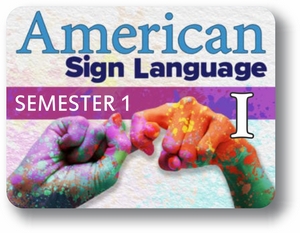American Sign Language I Semester 1: Introduction

Course Overview:
Did you know that American Sign Language (ASL) is the third most commonly used language in North America? American Sign Language 1a: Introduction will introduce you to vocabulary and simple sentences, so that you can start communicating right away. Importantly, you will explore Deaf culture – social beliefs, traditions, history, values and communities influenced by deafness.
General Note:
Sign order should not be the focus of this course. While students should make an effort to put things into ASL sign order when appropriate, grading should not be based on this. Please also be aware that while you may learn particular signs one way, it’s possible others may learn the same signs in a slightly different manner. As in any language, there are many variances between signs and signers, as well as regional and cultural differences. Signs may also be shortened or simplified for the ease of conversation.
Required Materials:
- Computer with:
- Internet access
- Word processing program
- Slideshow creation program
- Cell phone, tablet, or computer camera with sound and video recording abilities
- A person, large stuffed animal, or chair
- 2 people (family, friend, classmate) to use in videos and lead a discussion with
- A photo (or even a drawing) of your family
- A hat—silly, crazy, or ordinary is fine
- Blank Paper
- Drawing tools (pencils, markers, etc.)
Syllabus:
Unit 1: The Basics
Have you ever watched a sign language interpreter at a public event and thought— “Wow, what a beautiful and expressive language!”? Yes, sign language is an amazing visual language that is almost like a dance, with fine finger shapes, facial expressions, and expressive body movements. But American Sign Language is the language of communication for many, with rules and grammar just like any other official language. Each of those movements has a specific meaning and is part of a unique and fascinating language. Get ready to embark on an exciting new journey into the world of American Sign Language so you, too, can communicate in this exquisite way!
- Define American Sign Language
- Correctly perform the 26 signs of the American Manual Alphabet
- Count to 10 and greet someone in ASL
- Politely get a Deaf person’s attention
- Trace the origins of sign language in the United States
Unit 2: Let’s Introduce Ourselves!
Well, hi there! Nice to meet you. Being able to introduce yourself and communicate with others upon meeting is a necessary, everyday skill. Of course, when unable to do this in your native language, it can present quite a challenge, and you may possibly even run the risk of appearing rude. Needless to say, learning how to introduce yourself and mind your manners in an ASL setting is definitely an important skill to have. But don’t worry—soon you’ll be able to graciously introduce and tell a little bit about yourself so you can feel confident and comfortable if ever at a Deaf event.
- Understand why many Deaf people prefer to be called Deaf or Hard of Hearing
- Count to 20
- Introduce your family members
- Sign “please” and “thank you”
- Recognize how to appropriately interact at a Deaf event
Unit 3: Express Yourself: Feelings, Colors, & Questions
What is in a sign? Well, there are five things that make up a sign in ASL, and you can break those down to better understand how to sign words and sentences. Some very useful sentences include those that are questions or answers; consider, for example, when you want to get to know a new person. What do they like? Dislike? Want? Don’t want? All of this, as well as the elements that make up signs, are very important to basic conversation, so let’s get started!
- Name the five elements of a sign in ASL
- Identify marked and unmarked (natural) handshapes
- Tell someone whether you are Deaf or hearing in ASL
- Sign your emotions
- Ask and answer yes/no and ‘wh-’ questions
Unit 4: School’s in Session
Did you know that the football huddle originated when players on a Deaf college team crowded together to hide their sign language from the opposition? Or, did you have any idea that Benedictine monks had an interesting place in Deaf history? Knowing such background information can help us put American Sign Language into context, allowing us to better understand more about Deaf culture. Schools are an important part of Deaf history, so let’s learn to sign about everything that happens there! Plus, what does it take to be a member of the Deaf community? Together, we’ll explore more about how people identify with the community and all about the wide range of people you might meet there.
- Identify the two sides of the “methods debate” in Deaf education
- Describe how Alexander Graham Bell, inventor of the telephone, played a very negative role in Deaf history
- Turn just about any sentence into a question
- Sign basic sentences about school
- Appreciate the wide variety of people who are part of the Deaf community


